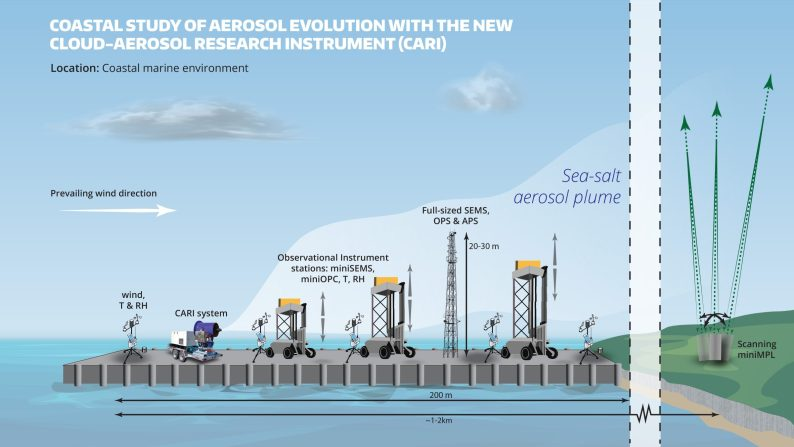Geography
Marine Cloud Brightening
- 24 Apr 2024
- 6 min read
For Prelims: Marine cloud brightening, Coral bleaching, Global warming, Great Barrier Reef, Intergovernmental Panel on Climate Change.
For Mains: Mechanism of Marine Cloud Brightening and Related Challenges and Risks, Environmental Pollution & Degradation, Conservation
Why in News?
Recently, scientists are testing a geoengineering technique called marine cloud brightening.
- This method involves using machines to inject tiny saltwater particles into marine stratocumulus clouds, aiming to increase their reflectivity and cool the Earth.
What is Marine Cloud Brightening?
- About:
- Marine cloud brightening is a scientific initiative that explores how altering atmospheric particles (aerosols) can impact cloud reflectivity.
- By releasing tiny aerosol particles into the atmosphere, researchers aim to enhance cloud brightness, leading to increased sunlight reflection.
- Aerosols of the right size and concentration could significantly increase the reflectivity of specific types of clouds.
- This phenomenon is visible in satellite images of clouds brightened by ship emissions (known as “ship tracks”).
- Goals of the Marine Cloud Brightening Program:
- Better understanding of the present-day effects of pollution aerosols on clouds.
- Investigate whether aerosol particles made from sea salt could be used to intentionally reduce near-term climate warming while greenhouse gas concentrations are brought down to safer levels.
- Understand the benefits, risks, and efficacy of the intentional use of aerosols to reduce warming through different implementations of marine cloud brightening.
Aerosol and Climate Effect:
- Aerosol concentration is declining due to expanding air quality regulations, leading to fewer particles in the atmosphere.
- Most aerosol particles have a cooling effect on climate, so their reduction adds to global warming.
- Scientists estimate that aerosols from human emissions are offsetting 0.5°C of global warming, but the actual cooling effect could range from 0.2°C to 1.0°C.
- Uncertainty about aerosol effects on clouds contributes to uncertainty in future warming projections.
What are the Challenges and Risks Associated with MCB?
- Technical Feasibility: MCB involves the large-scale spraying of seawater into the atmosphere at significant altitudes, which presents engineering complexities in terms of design, cost, maintenance, and operation of the spraying devices.
- Environmental Impacts: Alterations in cloud patterns and precipitation due to MCB could affect regional climate and hydrological cycles, potentially causing unintended consequences like droughts or floods.
- Changes in clouds over broad regions affect the circulation of the atmosphere, weather, and precipitation.
- Both marine cloud brightening (MCB) and pollution aerosols can change clouds, which in turn affects regions both nearby and far from where the brightening occurs.
- Ethical Issues: MCB raises ethical dilemmas about human intervention in natural processes and the governance and decision-making processes surrounding its implementation.
- Moral Hazard: MCB might lead to complacency among policymakers and the public, diminishing their commitment to reducing greenhouse gas emissions and adapting to climate change.
Conclusion:
- Marine Cloud Brightening (MCB), a cutting-edge climate intervention, remains in its early research and development stages. Scientists are diligently exploring its feasibility, efficacy, and potential impacts.
- Sustainable human adaptation is considered the sole novel approach among various geoengineering methods to mitigate global warming and address climate change, with acknowledgment of associated risks and uncertainties
|
Drishti Mains Question: Q. Discuss the various geoengineering techniques proposed to mitigate climate change and their potential impacts on global climate systems. How does sustainable human adaptation stand out as a unique approach in this context? |
UPSC Civil Services Examination, Previous Year Question (PYQ)
Prelims
Q. In the context of which of the following do some scientists suggest the use of cirrus cloud thinning technique and the injection of sulphate aerosol into stratosphere? (2019)
(a) Creating the artificial rains in some regions
(b) Reducing the frequency and intensity of tropical cyclones
(c) Reducing the adverse effects of solar wind on the Earth
(d) Reducing the global warming
Ans: (d)
Q. Consider the following statements: (2012) Chlorofluorocarbons, known as ozone-depleting substances, are used
- in the production of plastic foams
- in the production of tubeless tyres
- in cleaning certain electronic components
- as pressurizing agents in aerosol cans
Which of the statements given above is/are correct?
(a) 1, 2 and 3 only
(b) 4 only
(c) 1, 3 and 4 only
(d) 1, 2, 3 and 4
Ans: (c)
Mains:
Q. Bring out the relationship between the shrinking Himalayan glaciers and the symptoms of climate change in the Indian subcontinent. (2014)







